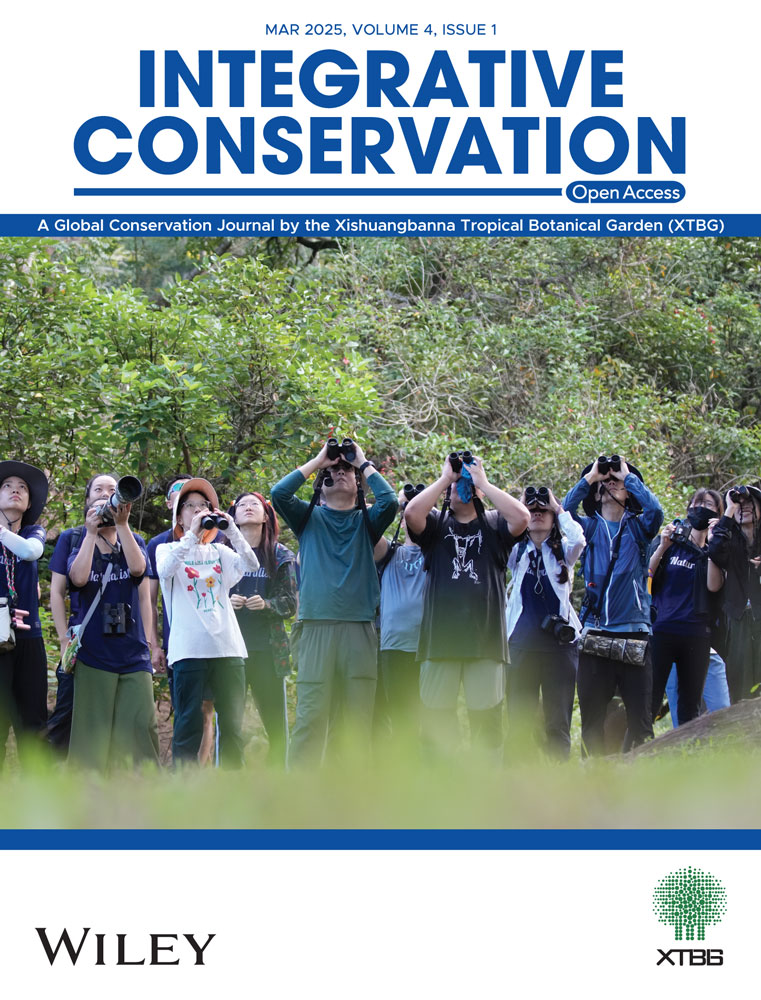Seed–Habitat Thermal Interactions Contribute to the Mosaic Distribution Patterns of Invasive Chromolaena odorata and Ageratina adenophora in South Yunnan, China
种子与生境之间的热相互作用促成飞机草和紫茎泽兰在中国云南南部的镶嵌式分布
Editor-in-Chief: Binbin Li; Handling Editor: Gbadamassi G. O. Dossa
ABSTRACT
enChromolaena odorata and Ageratina adenophora are invasive species in Southern Yunnan, China, where they demonstrate mosaic distribution patterns. Chromolaena odorata, a tropical species, grows primarily at low latitudes and/or low altitudes, whereas Ageratina adenophora is a temperate species and occurs at higher latitudes and/or higher altitudes. We hypothesised that the thermal interactions between these plants and their habitats contribute to their distribution patterns. To explore this, we investigated how temperature affects various seed traits and performance, including seed viability, high-temperature tolerance, seed longevity under heat stress, and temperature requirements for germination. Our seed ecology study used seeds of both species collected from three of four provenances: Menglun (ML: low latitude and low altitude in Xishuangbanna), Kongmingshan (KMS: low latitude and high altitude in Xishuangbanna), Pu'er (PE: middle latitude and high altitude), and Kunming (KM: high latitude and high altitude). Laboratory experiments were conducted to investigate changes in seed viability after heating at 40°C for 1–10 days and after heating at temperatures between 30°C and 95°C for 30 min. We also investigated seed germination under constant temperatures ranging from 10°C to 40°C, under daily alternative temperatures with warm periods of up to 21 h at 40°C and under water and NaCl stress up to −1.5 MPa. Our results revealed inter- and intraspecific variations in seed high-temperature tolerance of these two invasive species. Chromolaena odorata seeds exhibited greater tolerance to high temperatures, water, and NaCl stress compared to Ageratina adenophora seeds. Additionally, Chromolaena odorata seeds from low latitudes and/or low altitudes performed better than those from high latitudes and/or high altitudes. Conversely, Ageratina adenophora seeds from high latitudes and/or high altitudes performed better than those from low latitudes and/or altitudes. We conclude that high temperatures might influence the distribution of Chromolaena odorata and Ageratina adenophora by affecting seed development, ageing, and germination in the field, suggesting that the thermal adaptation of these invaders to their habitats plays a key role in their spread.
摘要
zh飞机草与紫茎泽兰系云南南部的入侵物种, 在此呈现镶嵌分布格局。飞机草是热带性质的, 生长于低纬度和 (或) 低海拔地区, 而紫茎泽兰是温带性质的, 分布在高纬度和 (或) 高海拔地区。我们的假说认为, 植物与其生境间的热相互作用有助于物种分布格局的形成。为此, 我们深入探究温度如何影响种子的特性及其表现, 例如生产具有不同活力、不同高温耐性的种子, 高温胁迫影响种子的寿命, 种子萌发具有不同的温度要求。我们分别从勐仑 (ML, 低纬度西双版纳的低海拔地区) 、孔明山 (KMS, 低纬度西双版纳的高海拔地区) 、普洱 (PE, 中纬度高海拔) 和昆明 (KM, 高纬度高海拔) 这4个采集地的中的3个采集飞机草和紫茎泽兰种子开展种子生态学实验。实验在实验室进行, 研究了在40°C热处理1-10 天及在30°-95°C热处理30 分钟后种子的活力变化。同时, 研究了种子在10°C至40°C之间的恒温条件下的萌发, 在每日最长21 小时的40°C热周期下的萌发, 以及在最低水势-1.5兆帕的水分和氯化钠盐胁迫下的萌发。结果表明, 这两种入侵植物的高温耐性存在种内和种间差异。对高温、水分和盐胁迫, 飞机草种子整体表现出比紫茎泽兰更高的适应性。同时, 从低纬度和 (或) 低海拔产地采集的飞机草种子比从高纬度和 (或) 高海拔产地采集的飞机草种子表现出更高的活力与耐性。相反, 从高纬度和 (或) 高海拔产地采集的紫茎泽兰种子比从低纬度和 (或) 低海拔产地采集的紫茎泽兰种子表现更好。由此得出结论, 高温通过种子发育、种子老化和野外萌发影响飞机草和紫茎泽兰的分布, 表明入侵种对入侵地的热适应在植物入侵过程中扮演着重要角色。
简明语言摘要
zh飞机草与紫茎泽兰都是云南南部臭名昭著的入侵物种, 在此呈现镶嵌分布格局。该研究从4个种子产地中的3个分别收集飞机草和紫茎泽兰种子, 在实验室开展实验, 研究在40°C热处理1-10 天及在30°-95°C热处理30 分钟后种子的活力变化, 及种子在10°C至40°C之间的恒温条件下, 在每日最长21 小时的40°C热周期条件下, 以及在最低水势-1.5兆帕的水分和氯化钠盐胁迫下的萌发。结果揭示了这两种入侵植物在高温耐性方面的种内和种间差异, 即是说对高温、水分胁迫和盐胁迫, 飞机草种子整体表现出比紫茎泽兰更高的适应性;同时, 从低纬度和 (或) 低海拔产地采集的飞机草种子比从高纬度和 (或) 高海拔产地采集的飞机草种子表现出更高的活力与耐性。相反, 从高纬度和 (或) 高海拔产地采集的紫茎泽兰种子比从低纬度和 (或) 低海拔产地采集的紫茎泽兰种子表现更好。由此得出结论, 高温通过种子发育、种子老化和野外萌发影响飞机草和紫茎泽兰的分布, 表明入侵种对入侵地的热适应在植物入侵过程中扮演着重要角色。
Summary
enChromolaena odorata and Ageratina adenophora are two of the most problematic invasive species in South Yunnan, China, where they show mosaic distribution patterns. In this study, we collected seeds of these two species, each from three of four provenances, and carried out laboratory experiments to investigate how temperature, water stress, and salt (NaCl) affect seed viability and germination. We heated seeds at 40°C for 1 to 10 days and at temperatures between 30°C and 95°C to test their tolerance to high heat. Our results revealed both species vary in their ability to tolerate high temperatures. Chromolaena odorata seeds were generally more tolerant to high temperature, water, and NaCl stress than Ageratina adenophora seeds. Chromolaena odorata seeds from lower latitudes and/or lower altitudes performed better than those from higher latitudes and/or higher altitudes. Conversely, Ageratina adenophora seeds from higher latitudes and/or higher altitudes were more resilient than those from lower latitudes and/or lower altitudes. Our findings suggest that high temperatures could influence the distribution of these species by affecting seed development, seed ageing, and seed germination, highlighting the role of thermal adaption in the spread of invasive plants.
- ●
Practitioner Points
- ○
Chromolaena odorata seeds generally show higher tolerance to high temperatures, water, and NaCl stress compared to Ageratina adenophora seeds (inter-specific differences).
- ○
Chromolaena odorata seeds from low-latitude and/or low-altitude regions performed better than those from high-latitude and/or high-altitude regions. In contrast, Ageratina adenophora seeds from higher latitudes and/or higher altitudes outperformed those from lower latitudes and/or lower altitudes (intraspecific variations).
- ○
High temperatures can influence the distribution of Chromolaena odorata and Ageratina adenophora by affecting seed development, seed ageing, and seed germination in the field, indicating that thermal adaption to new habitats plays a key role in the spread of these invasive species.
- ○
实践者要点
zh
-
相较于紫茎泽兰, 飞机草种子整体表现出了对高温、水分胁迫和盐胁迫更高的适应性 (种间差异) 。
-
从低纬度和 (或) 低海拔产地采集的飞机草种子比从高纬度和 (或) 高海拔产地采集的飞机草种子表现出更高的活力与耐性;相反, 从高纬度和 (或) 高海拔产地采集的紫茎泽兰种子比从低纬度和 (或) 低海拔产地采集的紫茎泽兰种子表现更好 (种内差异) 。
-
高温可能通过种子发育、种子老化和野外萌发影响飞机草和紫茎泽兰的分布, 表明入侵种对入侵地的热适应。
1 Introduction
Biological invasion is one of the most serious ecological problems worldwide, with detrimental effects on the economy, environment, and public health (Ferreras and Galetto 2010; Mack et al. 2000; Mazia et al. 2001; Schlaepfer et al. 2010; Vilà and Weiner 2004). It poses a significant threat to biodiversity (Beckmann et al. 2011; Lake and Leishman 2004; Perglová et al. 2009; Binggeli 1996; Simberloff et al. 2013; Verlinden et al. 2014; Vilà and Weiner 2004) and has become a key factor in recent extinctions (Thomas et al. 2004). Despite the formulation of several theories, such as the inherent superiority hypothesis (Lowry et al. 2013), the empty niche hypothesis (Hierro et al. 2005), the resource opportunity theory (Davis et al. 2000), the enemy release hypothesis (Keane 2002), the novel weapon hypothesis (Callaway and Ridenour 2004), and the evolution of increased competitive ability hypothesis (EICA; Blossey and Notzold 1995), the underlying mechanisms of biological invasion remain unknown. The ecological substance of plant invasion lies in the colonisation, population establishment, and proliferation of certain alien species in new environments.
Plant regeneration from seeds plays a pivotal role in plant invasions as it is often the initial stage in the invasion process. Although some invasive plant species rely entirely on asexual reproduction, many benefit from both sexual and asexual reproduction once established (Huebner 2022). Colonisation success is determined by many processes, with seed germination being the first step, regardless of whether the site offers an ideal growth habitat or presents a stressful environment with aggressive competitors (Luo and Cardina 2012). Seeds, as primary dispersal and propagation units, have many important functional traits that reflect plant adaptations to their surroundings, including size, shape, structure, germination requirements, and responses to abiotic stress (Saatkamp et al. 2018). Therefore, seed studies provide valuable insights into the processes involved in plant invasion.
Siam weed (Chromolaena odorata) and Crofton weed (Ageratina adenophora), both native to Mexico, are rapidly spreading across tropical and subtropical regions globally, including in China (He 2012; Global Invasive Species Database GISD 2024; Ma 2013; Xu and Qiang 2004). In southern Yunnan, these two invasive species exhibit a mosaic distribution pattern. Chromolaena odoratum usually grows in areas of low latitude and low altitude, such as Menglun in Xishuangbanna, whereas Ageratina adenophora is found at higher latitudes, such as Kunming. The two species co-occur in transition zones, including regions with middle latitudes, such as Pu'er, and areas at low latitudes but with high altitudes, such as Kongmingshan in Xishuangbanna. These distribution patterns make them ideal candidates for comparative studies on plant invasion.
We hypothesised that thermal interactions between these species and their habitats contribute to this mosaic distribution. To test this hypothesis, we investigated how this plant–habitat interaction affects seed traits and performance across various biological processes. These include seed viability and high-temperature tolerance, seed longevity in soil seed banks, and temperature requirements for germination. In this study, we examine the high-temperature tolerance and germination responses under high temperature and water stress of seeds from three of four invaded provenances to better understand how seed trait–habitat interactions influence the distribution of these two invasive species.
2 Materials and Methods
2.1 Seed Sources and Climate Conditions of Seed Provenances
Achenes of Ageratina adenophora and Chromolaena odoratum (hereafter referred to as seeds) were collected from three of the four sites in Yunnan, Southwest China. For Ageratina adenophora, seeds were collected from Panlong District in Kunming, Simao District in Pu'er, and Kongmingshan in Xiangming Town, Xishuangbanna. For Chromolaena odoratum, seeds were collected from Simao District in Pu'er, Kongmingshan in Xiangming Town, and Menglun Town in Xishuangbanna. The seeds were harvested in April and May 2021, when they were fully mature. Geographic and climatic details for each provenance are presented in Table 1.
| Plant species | Provenance | 100-seed weigh (g) | Moisture content (%) | Initial viability (%) |
|---|---|---|---|---|
| Ageratina adenophora | PE | 0.046 | 7.77 ± 0.64 | 64.17 ± 3.47b |
| KMS | 0.047 | 8.96 ± 0.96 | 73.33 ± 2.45a | |
| KM | 0.041 | 10.22 ± 0.72 | 69.33 ± 4.55ab | |
| Chromolaena odoratum | PE | 0.200 | 7.35 ± 0.59 | 68.67 ± 3.68 d |
| KMS | 0.213 | 7.61 ± 0.64 | 77.08 ± 2.33c | |
| ML | 0.258 | 7.88 ± 0.84 | 82.33 ± 2.16c |
- Note: KM: harvested from Panlong District in Kunming, E25°23ʹ24″, E102°55ʹ27″, altitude 1885 m, subtropical plateau mountain monsoon climate; Pu'er: from Simao District in Pu'er, N22°45ʹ30″, E101°59ʹ26″, 1415 m, low-latitude plateau south-subtropical monsoon climate; ML: from Menglun Town in Xishuangbanna, N21°41ʹ02″, E101°25ʹ39″, 570 m, tropical monsoon climate; KMS: Kongmngshan in Xiangming Town, Xishuangbanna, N22°07ʹ36″, E101°07ʹ39″, 1550 m, tropical monsoon climate. Those labelled with the same subscript did not have significantly inter-specific difference from each other.
After being taken back to the laboratory, the seeds were air-dried for several days. The 100-seed weight, moisture content, and initial viability were then determined (Table 1). The remaining seeds were stored in paper bags at 15°C and 15% relative humidity until initiation of the experiments, with storage duration not exceeding 6 months.
2.2 Seed Tolerance to Extremely High Temperatures
After maturation, seeds are typically shed onto the ground, and the maximum ground temperatures can reach extremely high values in South Yunnan, ranging up to 60°C–70°C. Such temperatures can negatively impact seed viability (An et al. 2023; Wen et al. 2015). To investigate the maximum temperature tolerance of the seeds, this experiment was designed to assess their endurance under high temperatures. Following Wen's method (2015), a water bath was used to produce a temperature regime from 30°C to 95°C in 5°C increments. Seeds, both air-dried and imbibed, were arranged in monolayers in large triangular flasks. They were heated for 30 min at each set temperature, then sown on 1% (w/v) plain agar for viability assessments. The seeds were incubated at 25°C under light conditions.
2.3 Effects of Continuous High-Temperature Treatment on Seed Viability
In South Yunnan, ground temperatures often exceed 40°C, a condition that is stressful for most tropical seeds, which inhibits germination and causes seed ageing. Thus, this temperature was selected as the treatment temperature and used to assess the effects of high-temperature stress on seed viability. Seeds sown in Petri dishes containing 1% plain agar were first heated at 40°C for varying durations, ranging from 0 to 96 h in 12-h increments and up to 10 days in 1-day increments. Following the designated heating period, the seeds were transferred to 25°C for viability assessments. Seeds incubated at 25°C without prior exposure to the 40°C treatment served as the control (0 h).
2.4 Effect of Incubation Temperature on Seed Germination
This study was designed to investigate the temperature requirements for seed germination. Seeds were sown in Petri dishes containing 1% plain agar, which were then randomly assigned to incubators set at constant temperatures of 10°C, 15°C, 20°C, 25°C, 30°C, 35°C, and 40°C. The seeds were exposed to light provided by fluorescent lights throughout the incubation period.
2.5 Effects of Periodic High Temperature on Seed Germination
Previous studies have documented that the maximum ground temperature in gaps of the Xishuangbanna tropical rainforest can reach 40°C (Liu et al. 2000), with the duration of ground temperature ≥ 40°C varying depending on the size of the forest gap. In this experiment, Petri dishes containing seeds sown on 1% plain agar were alternately moved between two incubators set at 40°C and 25°C daily. This allowed the seeds to experience 40°C for a designed duration, ranging from 1 to 21 h, as part of different treatment groups. Seeds that were incubated at a constant 25°C without daily heating served as the control (0 h).
2.6 Effects of Water Availability on Seed Germination
To assess the effects of water availability on seed germination, testing solutions with water potentials ranging from −0.1 up to −1.5 MPa were prepared using polyethylene glycol (PEG) 8000, following Michel (1983). Deionised water was used as the control (0 MPa). Seeds were sown in 9 cm-diameter Petri dishes lined with filter paper, moistened with 2.5 mL of the testing solutions, and incubated at 25°C under light. Petri dishes for each treatment were sealed in resealable double-clear plastic bags to minimise any changes in water potential during the experiment. Seed germination was assessed twice a week, and the filter paper and testing solutions were refreshed at these intervals. Ungerminated seeds were removed from the water stress treatments after 4 weeks and re-incubated on filter paper moistened with deionised water for an additional 2 weeks to test their viability.
2.7 Effects of NaCl Stress on Seed Germination
This experiment followed the same procedure as the water availability experiment described above. However, testing solutions with different water potentials (ranging from −0.1 to −1.5 MPa) were prepared using reagent-grade NaCl, as outlined by Lang (1967).
2.8 Seed Viability Assessment and Germination Tests
For each treatment, 50 seeds with six replicates were used. Unless otherwise stated, seed viability was assessed through germination tests, which were conducted as follows: seeds were incubated on 1% agar at 25°C under light and scored weekly for at least 6 weeks. The formation of morphologically normal seedlings was used as the criterion for germination in the germination requirement experiments and viability in the viability testing experiments. The ungerminated seeds were pinched using forceps. Those that remained white and firm were assumed to be viable, whereas the remainder were deemed nonviable.
2.9 Data Analysis
Seed viability and germination data were used as dependent variables for analysis after arcsine-square-root transformation, as these data typically do not follow a normal distribution. A three-way or four-way analysis of variance (ANOVA) was performed, with all environmental factors treated as fixed effects. Interactions between factors were also evaluated. However, only treatments that resulted in germination were included in the analysis. All statistical analyses were performed using SPSS 16.0 for Windows. Data are presented as means ± standard errors based on six replicates of 50 seeds.
3 Results
3.1 Initial Seed Traits and Comparisons
Overall, Chromolaena odoratum seeds were larger than those of Ageratina adenophora. Amongst the different provenances, seeds from Pu'er showed the lowest initial viability for both species (Table 1). Analysis of variance revealed that provenance significantly affected seed viability (Supporting Information S1). Chromolaena odoratum seeds from both Menglun and Kongmingshan had significantly higher viability than those from Pu'er. Similarly, Ageratina adenophora seeds from Kongmingshan had significantly higher viability than those from Pu'er, although seeds from Kunming did not differ significantly from those of either Kongmingshan or Pu'er (Table 1).
3.2 Seed Tolerance to Extremely High Temperatures
All factors—species, seed provenance, hydration state, and heating temperature—as well as their interactions significantly affected seed viability (p < 0.001 for all factors, except for S × P × H × T, where p = 0.074; Supporting Information S1). An anomaly was observed in the low viability (32.33% ± 1.89%) of air-dried Chromolaena odoratum seeds from Pu'er after heating at 35°C; however, a later verification test determined a viability of 71% ± 3.38% (Figure 1b). Most dry seeds exhibited minimal viability loss after heating at temperatures up to 90°C, though none survived at 95°C. Heating for 30 min at 60°C markedly reduced the viability of imbibed seeds, with few Ageratina adenophora seeds surviving and none of the Chromolaena odoratum seeds surviving after heating at 70°C or higher. Amongst the provenances, Ageratina adenophora seeds from Kongmingshan had the best germination performance, whereas Chromolaena odoratum seeds from Menglun performed best across the three provenances (Figure 1).
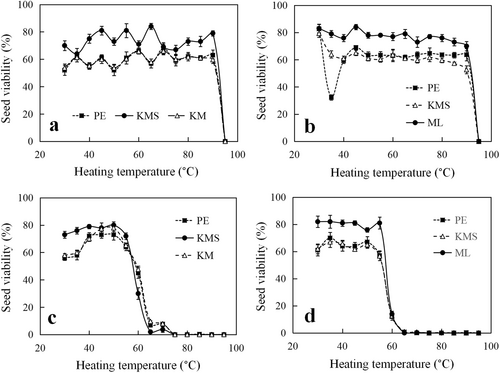
3.3 Effects of Continuous High-Temperature Treatment on Seed Viability
All investigated factors and their interactions significantly affected seed viability (p < 0.001 for all; Supporting Information S1). Overall, Chromolaena odoratum seeds had notably higher tolerance to continuous high-temperature stress at 40°C compared to Ageratina adenophora seeds (Figure 2). After 10 days of exposure, Ageratina adenophora seeds lost more than half of their viability, with seeds from Pu'er showing the greatest decline (< 10% survival). In contrast, Chromolaena odoratum seeds experienced little to no viability loss, with seeds from Menglun showing no loss and those from Kongmingshan and Pu'er showing only minimal reductions.
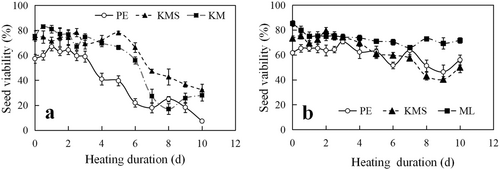
3.4 Effect of Incubation Temperature on Seed Germination
Analysis of variation found that all investigated factors, along with their interactions, significantly affected seed germination (species at α = 0.05 level, S × P at a marginal level, and the remaining factors at α = 0.01 level; Supporting Information S1). The two species had distinct temperature requirements for germination. At 10°C, about half of Ageratina adenophora seeds germinated, with seeds from Kunming showing the highest germination percentages, while only a few Chromolaena odoratum seeds germinated at this temperature. In contrast, more than half of Chromolaena odoratum seeds germinated at 35°C, with seeds from Menglun having the highest germination, while only a few Ageratina adenophora seeds germinated. No seeds of either species germinated at 40°C (Figure 3).
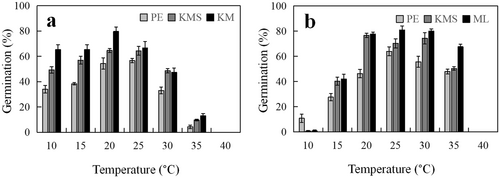
3.5 Effects of Periodic High Temperature on Seed Germination
All investigated factors and their interactions significantly affected seed germination (p < 0.001 for all; Supporting Material 1). Daily heating ≥ 7 h at 40°C significantly reduced Ageratina adenophora seed germination, with seeds from Pu'er consistently showing the lowest germination percentages. Chromolaena odoratum seeds demonstrated marked intraspecific variation. Seeds from Pu'er displayed significantly reduced germination after ≥ 5 h of daily heating, while seeds from the other two provenances did not exhibit a reduction in germination until the daily heating duration reached 12 h. Seeds from Pu'er had the lowest germination and the highest sensitivity to high temperatures (Figure 4).

3.6 Effects of Water Availability on Seed Germination
Ageratina adenophora seeds were more sensitive to water stress than Chromolaena odoratum seeds, with the former quickly showing a marked reduction in germination as water potential decreased. Only a few Ageratina adenophora seeds germinated when water potential was reduced to −0.8 MPa and below, while this turning point was −1.2 MPa for Chromolaena odoratum seeds. Seed provenance significantly affected the germination of Chromolaena odoratum seeds but had little effect on Ageratina adenophora seeds. At the water potentials between 0 and −1.2 MPa, Chromolaena odoratum seeds from Menglun exhibited the highest germination percentage, while those from Pu'er showed the lowest, with seeds from Kongmingshan falling in between (Figure 5; Supporting Information S1). Most seeds that failed to germinate when incubated at water potentials between −0.8 and −1.5 MPa resumed germination once the water stress was removed (data not shown).
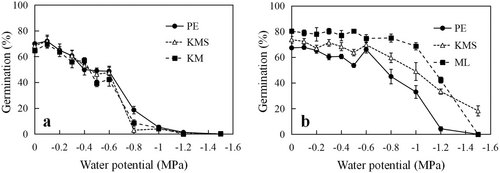
3.7 Effects of NaCl Stress on Seed Germination
Similar to the water availability experiment, Ageratina adenophora seeds were more sensitive to NaCl stress than Chromolaena odoratum seeds. Incubated under NaCl stress with a water potential of −0.8 MPa, 40–70% Chromolaena odoratum seeds germinated, while only a few Ageratina adenophora seeds (≤ 5%) did. Seed provenance affected seed germination in both species, although the effect was more pronounced in Chromolaena odoratum. For Chromolaena odoratum, the order of sensitivity to NaCl stress was PE > KMS > ML, whereas it was KM > KMS > PE for Ageratina adenophora (Figure 6; Supporting Information S1). As with the water availability experiment, most ungerminated seeds incubated at water potentials between −0.8 and −1.5 MPa germinated soon after the stress was removed (data not shown).
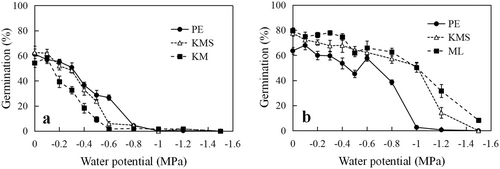
4 Discussion
Although Ageratina adenophora spread naturally into China, Chromolaena odorata was intentionally introduced as a spice plant. Both species entered the country via similar invasive routes around the same time, from Myanmar into South Yunnan around the 1930s—marking the first recorded instances of their appearance in China (He 2012; Hu et al. 2013; Liu et al. 1985; Xu and Qiang 2004). Ageratina adenophora was first documented in Menghai County, Xishuangbanna, in 1940, from where it spread northward to Pu'er and Kunming and eastward to Kongmingshan (Sang et al. 2010). Recent research has found that Ageratina adenophora in China has a distinctly expanded ecological niche and exhibits greater invasiveness compared to its counterpart in Mexico (Xian et al. 2023).
Chromolaena odorata has two independent introduction recordings in Asia: one from Jamaica in 1845 and another from the West Indies around 1920 (Yu et al. 2014). It was first introduced to South Yunnan in 1934 (He 2012). Yu et al. (2014) found that Chromolaen aodorata populations in Asia have extremely low genetic diversity compared to those in its native range, but the genotype in Asia demonstrates strong competitive ability.
These two invasive species co-occur in South Yunnan, where they demonstrate a mosaic distribution pattern. Ageratina adenophora predominantly thrives in northern regions, whereas Chromolaena odorata is more common in the south. Transition areas, particularly those at intermediate latitudes or low latitudes with high altitudes, appear to be less suitable for both species.
Using Ageratina adenophora and Chromolaena odoratum seeds collected from three of the four provenances, we investigated their tolerance to high temperatures and their germination under stress conditions. The study revealed both inter- and intraspecific differences in seed responses. Both species produced seeds exhibiting tolerance to extremely high temperatures, confirming earlier findings on the strong heat tolerance of invasive species growing in open ground in Xishuangbanna, such as Tithonia diversifolia (Wen 2015), Amaranthus spinosus (Ye and Wen 2017), Ageratum conyzoides, and Conyza Canadensis (Yuan and Wen 2018). In this study, Ageratina adenophora and Chromolaena odorata seeds in air-dried status showed no significant viability loss after 30 min of heating up to 90°C (Figure 1). However, inter-specific differences were revealed in the following experiments.
The seeds of both species demonstrated a wide temperature range for germination, from 10°C to 35°C. Compared with Ageratina adenophora seeds, Chromolaena odorata seeds generally had a higher temperature requirement for germination. While most Chromolaena odorata seeds germinated at 35°C, only a few germinated at 10°C. In contrast, Ageratina adenophora seeds had good germination performance at 10°C but low germination percentages at 35°C (Figure 3). Neither species germinated at a constant temperature of 40°C. However, Chromolaena odorata seeds were more tolerant to longer daily exposures to 40°C than Ageratina adenophora seeds under conditions with periodic heating. Interestingly, Chromolaena odorata seeds from Pu'er were sensitive to daily 5-h exposure at 40°C, while Ageratina adenophora seeds exhibited tolerance to this treatment (Figure 4).
In continuous high-temperature experiments, Chromolaena odorata seeds exhibited superior tolerance. After 10 days of exposure to 40°C, most Ageratina adenophora seeds lost viability, while Chromolaena odorata seeds survived (Figure 2). This suggests that Chromolaena odorata seeds have greater longevity under high-temperature stress (Long et al. 2008). Furthermore, Chromolaena odorata seeds were much less sensitive to water and NaCl stress than Ageratina adenophora seeds (Figures 5 and 6). These differences underline the distinct ecological characteristics of the two species: Chromolaena odorata is a tropical plant, while Ageratina adenophora is more temperate.
The differing, yet overlapping, climate niches of these two invaders in South Yunnan are shaped by the region's mountainous topography, which provides both suitable and marginal habitats for their growth. The thermal interaction between plants and their habitats affects the seed survival and germination of invaders in the field, contributing to the success or failure of these species' invasions into new areas.
At the same time, this study revealed marked intraspecific variations in both invaders. Despite a large difference in seed weight—Chromolaena odorata seeds were approximately five times heavier than Ageratina adenophora seeds (0.224 g vs. 0.0447 g per 100 seeds)—both species had high initial viability, though with obvious intraspecific variation depending on seed provenance (64–82% germination). Seeds harvested from sites where the species grew better generally had higher quality. Specifically, Chromolaena odorata seeds from Menglun and Ageratina adenophora seeds from Kunming and Kongmingshan had higher initial viability than their counterparts from less suitable sites (Table 1). Similarly, Chromolaena odorata seeds from Menglun often exhibited the highest tolerance across all high-temperature experiments in this study, while those from Pu'er were the most sensitive, and those from Kongmingshan exhibited intermediate tolerance (Figures 1-4). This pattern was particularly evident in the daily periodic heating experiment, in which Chromolaena odorata seeds from Pu'er were the most sensitive to heat amongst the three provenances (Figure 4b). For Ageratina adenophora, seeds from Kunming had better germination performance across a wider temperature range than those from Kongmingshan (Figure 3a) but displayed lower tolerance to high temperatures. Seeds from Pu'er consistently performed the worst (Figures 1, 2, and 4a).
These intraspecific variations suggest an adaptative response of the invaders to local environmental conditions and highlight the maternal influence on seed development, viability, and high-temperature tolerance. A previous study reported that germination behaviour can vary based on the environmental conditions experienced by the mother plant during seed maturation (Corkidi et al. 1991). Invasive species growing in more favourable habitats tend to produce seeds with higher viability and greater tolerance, indicating the thermal interactions between plants and their environments during seed development.
The invasion of exotic plants occurs due to their ability to outperform native species in the areas where they are introduced, allowing them to proliferate and cause harmful effects on the economy, environment, and/or human health (Cui and He 2009). However, the underlying mechanisms enabling this outperformance remain unclear. Understanding invasiveness is key to unravelling the mechanisms of biological invasion. Comparative studies are important in this regard, as they offer new insights into the traits that make certain species successful invaders (Maillet and Lopez-Garcia 2000). Comparing closely related taxa is particularly effective for identifying characteristics of successful invaders, as it minimises biases associated with phylogenetic distance and habitat affinities between species compared (Maillet and Lopez-Garcia 2000; Perglová et al. 2009).
As invasive plants, Ageratina adenophora and Chromolaena odoratum are very closely related and share many traits: they are both perennial herbaceous shrubs from the same family (indicating close phylogenetic relatedness), originally from Mexico and Central America (sharing the same native range), and produce numerous small pappus-bearing achenes (high fecundity and anemochory). Both species also release allelochemicals (a ‘new weapon’ mechanism), are cosmopolitan toxic weeds naturalised in tropical and subtropical areas (invading similar areas), and are aggressive competitors that form dense stands, inhibiting the establishment of other plant species (ecologically damaging in similar ways). Furthermore, both species followed the same invasion route into China, and they have overlapping distributions in South Yunnan, where they co-occur in transitional areas. This overlap makes them an ideal case for a comparative study of plant invasion.
In this study, the two species investigated, Chromolaena odorata and Ageratina adenophora, were both invasive and aggressive, with the four seed provenances (Kunming, Pu'er, Menglun, and Kongmingshan) all representing areas susceptible to plant invasion. However, the question remains: Why do these species succeed at some sites but fail or perform less successfully at others? To address this, laboratory experiments using seeds collected from these provenances were performed, eliminating possible interference. The results suggest that ecological adaptation is the most critical factor for successful invasion.
Although plant invasion involves all stages of the invader's life cycle, seed production and germination are the most important phases during the invasion process (Huebner 2022; Luo and Cardina 2012; Perglová et al. 2009; Wen 2015). Several germination traits are associated with invasiveness, including the ability to germinate under a wide range of conditions, non-dormancy, the capacity to germinate without pretreatment, rapid germination, and high germination percentages (Goodwin et al. 1999; Luo and Cardina 2012; Radford and Cousens 2000; Perglová et al. 2009; Pyšek and Richardson 2007; Schlaepfer et al. 2010). Previous studies have suggested the importance of seed high-temperature tolerance for tropical invasive plants in open areas (Wen 2015; Ye and Wen 2017; Yuan and Wen 2018). This study further confirms that invaders growing on open ground in Xishuangbanna produce seeds with a strong tolerance to high temperatures.
In conclusion, this study suggests that the ecological adaptation of invaders to invaded areas is the most fundamental factor for invasion success. The thermal interaction between plants and their habitats affects seed development, leading to inter- and intraspecific differences in seed quality and other traits. These variations influence seed survival and germination in the field and ultimately determine the invasion success of Chromolaena odorata and Ageratina adenophora, playing a critical role in plant invasion dynamics.
Author Contributions
Bin Wen: conceptualisation, data curation, formal analysis, funding acquisition, methodology, project administration, supervision, validation, visualisation, writing – original draft, writing – review and editing. Zhufang Zhao: data curation, investigation. Siqi Wang: data curation, investigation. Xuejing Yin: data curation, investigation. Liping He: conceptualisation, writing – review and editing. Ligang Chen: conceptualisation, writing – review and editing.
Acknowledgments
We are grateful to the National Natural Science Foundation of China (31971573) for providing financial support for this research, and the Seedbank of Xishuangbanna Tropical Botanical Garden is thanked for the laboratory experiments that were performed there.
Ethics Statement
The authors have nothing to report.
Conflicts of Interest
The authors declare no conflicts of interest.
Open Research
Data Availability Statement
The data that support the findings of this study are available from the corresponding authors upon reasonable request.



